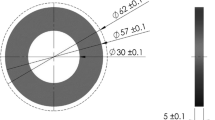Abstract
The main advantage of CBN grinding wheels is the long wheel life owing to the hardness of the CBN abrasive. Recent research has confirmed another advantage of CBN, which is cooler grinding. The new research allows the temperature in grinding to be predicted based on experimentally validated CBN thermal properties. This work also provides for in-process prevention of thermal damage in grinding. A well-documented feature of CBN grinding is the reduced risk of thermal damage to the workpiece. This advantage can allow a marked increase in removal rate whilst maintaining surface quality of the component compared to grinding with conventional abrasives such as aluminium oxide. The reduced risk of thermal damage in CBN grinding is sometimes attributed to the lower grinding specific energies. While lower specific energies when achieved are an advantage, this explanation ignores a fundamental advantage of the CBN abrasive. The experimental investigation has shown that a major advantage of CBN grinding is that a substantially lower proportion of the total grinding energy enters the workpiece compared to grinding with alumina wheels. The results further indicate that the effective thermal conductivity of CBN grains is considerably lower than its reported theoretical value of 1300 W(mK)−1.
Similar content being viewed by others
References
W. B. Rowe, M. N. Morgan and D. R. Allanson, “An advance in the modelling of thermal effects in the grinding process”,Annals CIRP,40(1), pp. 339–345, 1991.
R. C. DeVries, “Cubic Boron Nitride: Handbook of properties”,General Electric Report No. 72CRD178, 1972.
W. B. Rowe, S. C. E. Black, B. Mills, H. S. Qi and M. N. Morgan, “Investigation of heat transfer in grinding”,Annals CIRP, 44(1), pp 329–332, 1995.
W. B. Rowe, H. S. Qi, M. N. Morgan and H. W. Zheng, “The effect of deformation on the contact area in grinding”,Annals of the CIRP,42(1), pp. 409–413, 1993.
W. B. Rowe, J. A. Pettit, A. Boyle and J. L. Moruzzi, “Avoidance of thermal damage in grinding and prediction of the damage threshold”,Annals CIRP,37(1), pp. 557–559, 1988.
J. C. Jaeger, “Moving sources of heat and the temperature at sliding contacts”,Proceedings of the Royal Society of New South Wales,76, pp. 203–224, 1942.
T. D. Howes, K. Neailey and A. J. Harrison, “Fluid film boiling in shallow-cut grinding”,Annals CIRP,36(1), pp. 223–226, 1987.
S. Kelly, W. B. Rowe and J. L. Moruzzi, “Adaptive grinding control”,Advanced Manufacturing Engineering 1, pp. 287–295, 1989.
W. B. Rowe, D. R. Allanson, J. A. Pettit, J. L. Moruzzi and S. Kelly, “Intelligent CNC for grinding”,Proceedings IMechE 205, pp. 233–239, 1991.
Author information
Authors and Affiliations
Rights and permissions
About this article
Cite this article
Rowe, W.B., Black, S.C.E. & Mills, B. Temperature control in CBN grinding. Int J Adv Manuf Technol 12, 387–392 (1996). https://doi.org/10.1007/BF01186926
Issue Date:
DOI: https://doi.org/10.1007/BF01186926




